Assessment of the level of carbon dioxide in the room with air conditioning
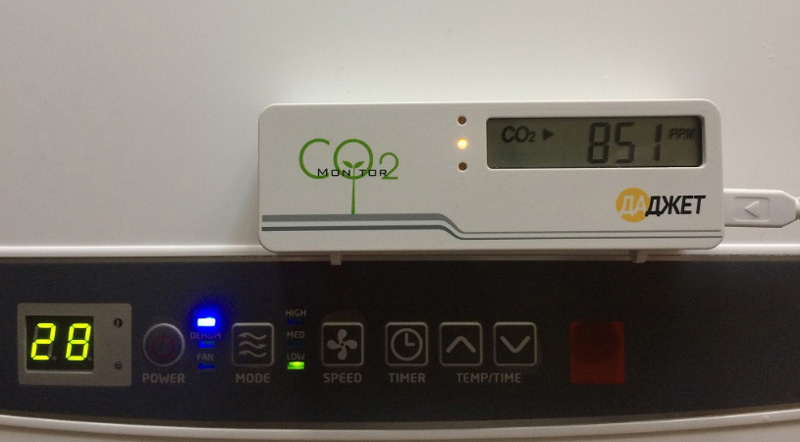
There are truths, familiar to any person almost from birth. It is cold in winter and warm in summer. When breathing, oxygen is consumed and carbon dioxide is released. When a lot of carbon dioxide accumulates in the room, it becomes stuffy, and in order to become more comfortable in the room - it needs to be ventilated. But most people tend to underestimate the effect of increased CO2 concentrations on health and quality of life. This is what I want to talk about in this article, and also to show how air conditioning affects the air purification process. And at the same time provide an overview of the CO2 level detector, which helps keep indoor air quality under control.
Content
• 1 What you need to know about CO2
• 2 Technical information
• 3 Appearance and principle of operation
• 4 Measurements
• 5 Home automation
• 6 Conclusions
1. What you need to know about CO2
CO2 or carbon dioxide is an integral part of any air mixture, the content of which is measured in ppm - parts per million. Conditionally normal levels of CO2 in fresh outdoor air are considered to be 400ppm. This figure is not constant and depends on a specific location - for example, in an ecologically clean area with no industry and low population density, the carbon dioxide content in the atmosphere can be below average, and in a densely populated metropolis, and even with industrial enterprises, it will almost certainly be above average.
Indoor air is considered to be of good quality if its CO2 content fluctuates within 800ppm. When reaching a carbon dioxide concentration of 1000ppm, many people already have a feeling of stuffiness and lethargy, and 1400ppm is the limit of the norm, as recommended by San Pina.
The dangerous level is 30000ppm - when such a CO2 concentration is reached, a person's heart rate increases, there is a feeling of nausea and other symptoms of oxygen starvation. The good news is that it is almost impossible to “inhale” such a concentration of carbon dioxide in office and residential premises, even of very poor quality. Nevertheless, even small excess of the permissible concentration of CO2 can significantly affect the quality of life. Already at 1000ppm, attention concentration decreases, a feeling of lethargy appears, the brain begins to process information worse. With a CO2 concentration above 1400ppm in the office, it becomes difficult to concentrate at work, and at home there will be trouble sleeping. The CO2 content depends, to a large extent, on the number of people in a closed room.
“You can control only what can be measured,” wrote Peter Drucker, the founder of modern management theory. And the first step to managing the indoor climate is to start tracking its objective indicators.
This is what the carbon dioxide detector from Dadzhet company will help us with.
2. Technical information
Model name: CO2 detector (Mini Monitor CO2)
CO2 measurement range: 0 - 3000 ppm
Temperature measurement range: 0 - 50
Measurement accuracy: ± 10% ppm, ± 1.5 ° C
Information output: LCD display, LED indicators
Current consumption: up to 200mA
Additional functions: sound signal of excess CO2 concentration
3. Appearance and principle of operation

The CO2 detector is supplied in a cardboard box containing information about the manufacturer and a brief checklist on the effect of elevated concentrations of carbon dioxide on human well-being.
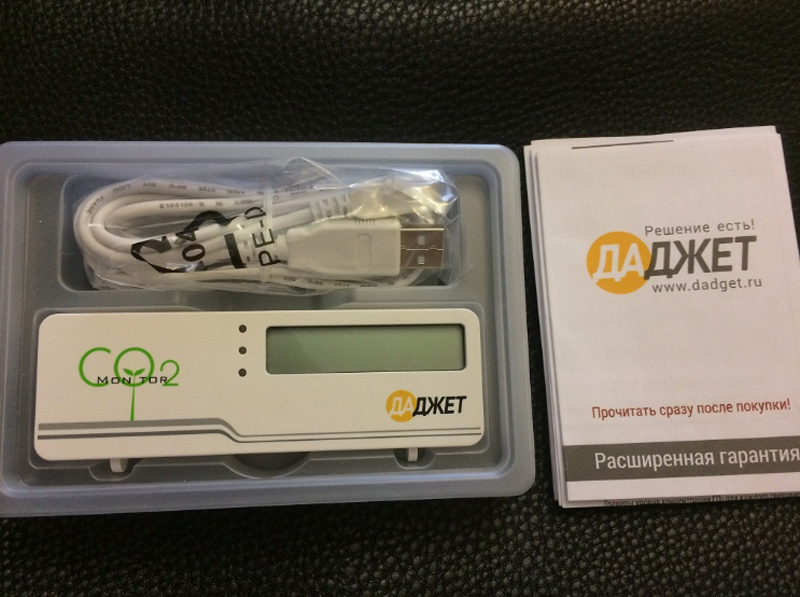
Inside is the device itself, the instruction manual in Russian and the USB cable. The detector does not have a built-in battery, so it can only work from an external power source: a USB port of a computer or a conventional charger for a smartphone.
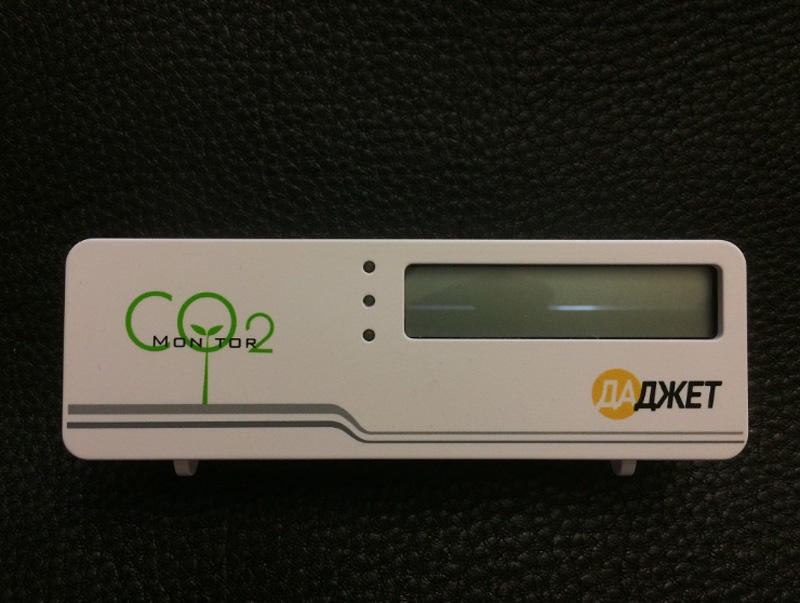
The device itself is a close-up. The front panel contains a screen and three indicator LEDs that display average measurement results: when the CO2 concentration is below 800ppm, the green LED is lit, at 800-1200ppm - yellow, above 1200ppm - red. The values of the intervals of action indicators can be changed in the settings.
In general, the LED display turned out to be a very informative thing. No need to approach the device and peer into the current values of the indicators. From a distance it can be seen that if the indicator has switched from green to yellow, then the room can already be ventilated, and if it turns red, it is advisable to start airing right now.
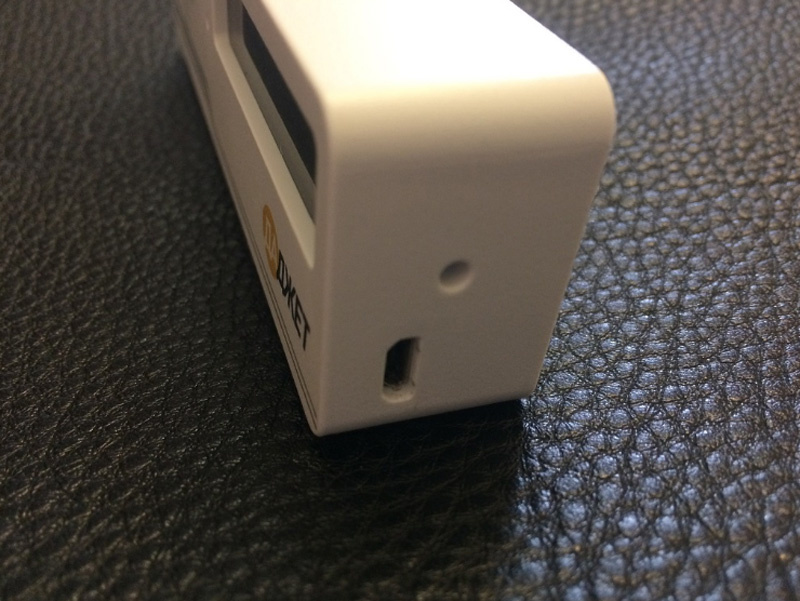
On the right side there is a microUSB-port and a hole through which air is taken for analysis.
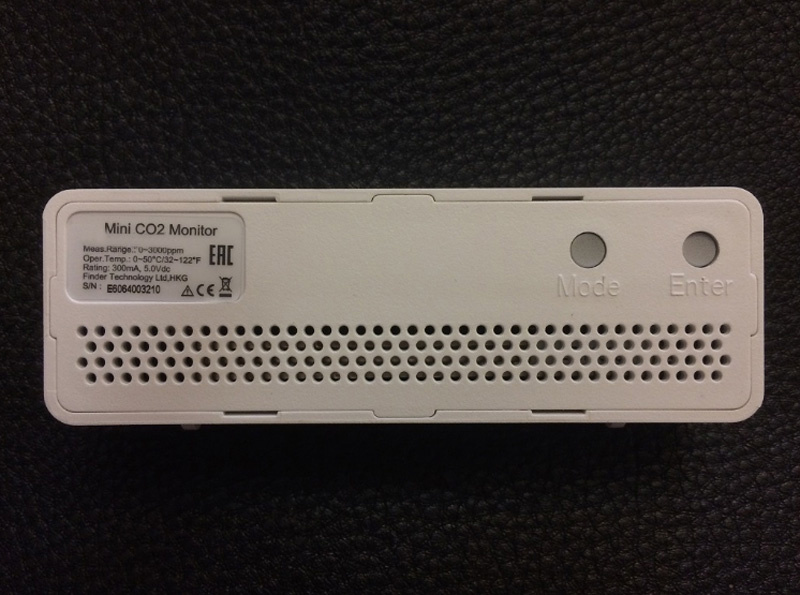
Behind the vents for ventilation, a sticker with technical information and two buttons that are used for setting.

The heart of the device is the ZGm053UK carbon dioxide sensor, which uses the NDIR technology (non-dispersive infrared radiation): the air flow enters the light guide tube and is emitted by an infrared lamp, and an infrared detector with an appropriate filter is on the other end of the tube. The more CO2 is contained in the air mixture, the more the infrared glow weakens, which allows the sensor to determine the current CO2 concentration.
The cost of NDIR sensors is higher than that of analogs with a different principle of operation (electrochemical or electroacoustic), but they also have a long service life and provide more accurate results.
4. Measurements
Now let's test the detector at work. The measurement location is Chelyabinsk, a two-room apartment in a relatively quiet area, with windows facing the courtyard.
Experience number 1. Getting to know the device
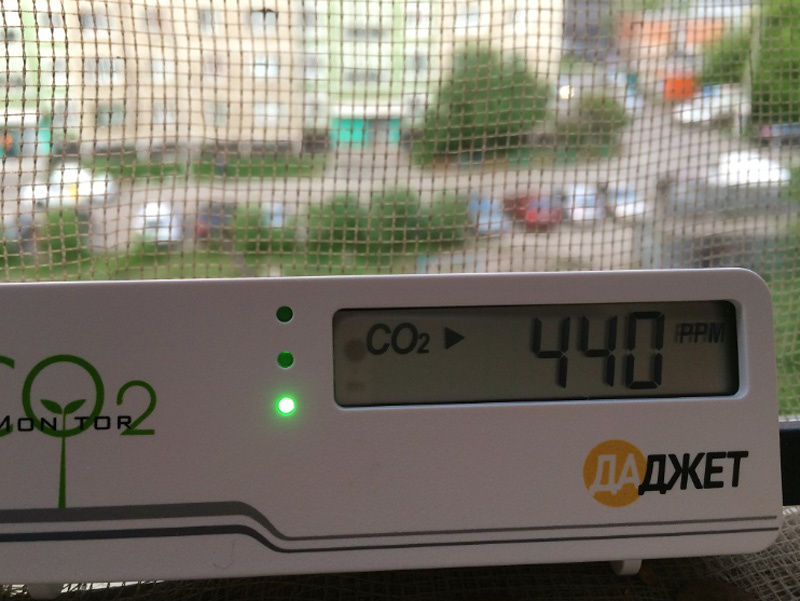
First of all, I measured the concentration of carbon dioxide on the street, placing the detector near the open window on the 4th floor.
Measurements showed 440ppm. The normal level of CO2 in the atmosphere, recall, is 400ppm. Well, adjusted for calm weather and living in an industrial metropolis with a traditionally problematic environment, 440ppm can be considered a normal result.
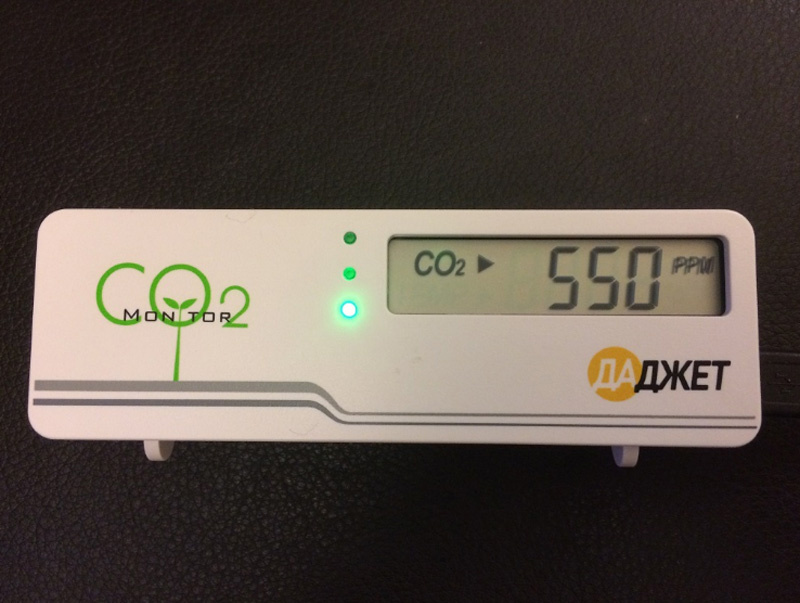
Now we measure the level of CO2 in the apartment itself, having previously well ventilated all the rooms.
It turned out 550ppm. This is an excellent result, the air is almost like outside.
But, looking ahead, I will say: to maintain such air quality on an ongoing basis in an apartment that is not equipped with advanced ventilation systems is almost impossible.
Experience number 2. Long-term measurements
In the course of the review, I have not yet mentioned that the detector not only displays the instantaneous values of CO2 concentration, but is also able to work in conjunction with a computer.
If you install a special program, the device will record the level of CO2 concentration and temperature in the room with reference to time and build a graph based on these indicators.
Further measurements will be carried out using this program.
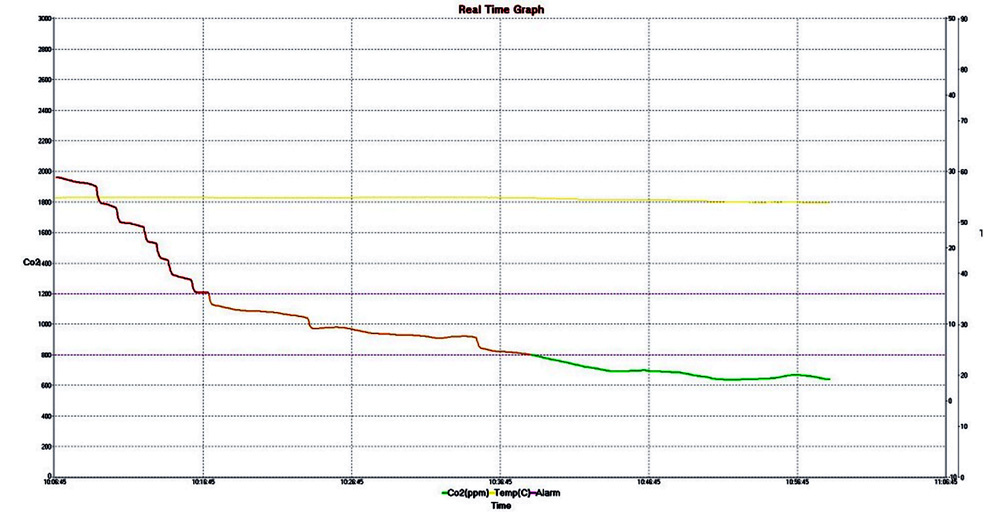
Night with closed window and door. By morning, the CO2 concentration in the room jumps to almost 2000ppm.
Open the window sash for airing and look at the chart. In about 40 minutes, the carbon dioxide concentration decreases from 2000ppm to a healthy level of 700ppm.

Evening. The natural noise dies away and the voices of the rest in the yard of the companies become especially audible. They interfere, so close the window.
In an hour, the CO2 concentration almost doubles, from 700ppm to 1300ppm.
Experience number 3. Daily monitoring
Now let's see how the concentration of CO2 in a room changes over the course of one full day.
Baseline: all the same two-room apartment, in which at the same time are from one to three people. The window in the kitchen is almost always open, the windows and the balcony door in the rooms open and close during the day, the interior doors are closed at night.
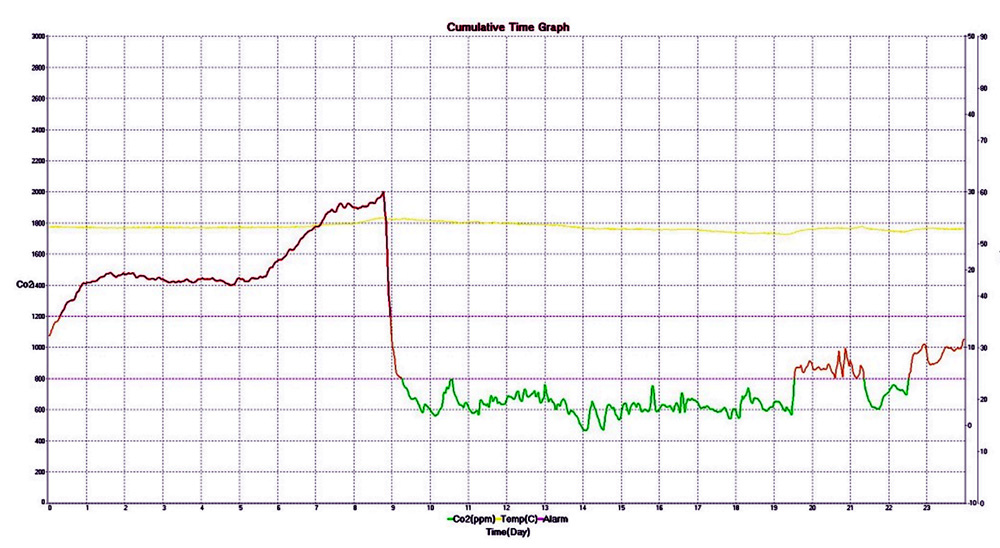
I air the room well before bedtime, close the window and go to bed.
By midnight, the CO2 concentration has already been exceeded, but until five o'clock in the morning it remains at a level that with a stretch can be called satisfactory. In the time interval from five to nine in the morning, the CO2 concentration rises to 2000ppm. By the way, it is completely correlated with personal feelings when sleeping with a closed window. Somewhere at 5 am I wake up in a rather awake state, but since it is still too early, I stay in bed to sleep before the alarm bell rings. At 7 am I wake up with a heavy head and in a depressed mood, as if I hadn’t slept all night - by this time the body is already breathing in "bad" air, which affects our well-being.
From 9 to 10 hours - airing. Opened windows in all rooms, CO2 concentration drops from 2000ppm to 600ppm.
From 10 to 15 o'clock - the windows in the rooms are closed, the window is open in the kitchen. The apartment has 1 person. CO2 concentration is normal.
From 15 to 18 o'clock - the vents are open in all rooms. The apartment has 2 people. CO2 concentration is still normal.
From 18 to 21 hours - the vents are open in all rooms. The apartment has 3 people. The CO2 concentration begins to increase, the vents no longer save.
From 21 to 22-30 hours - airing with open windows. The apartment has 3 people. CO2 concentration returns to normal, but begins to rise immediately, it is necessary to close the windows and leave some vents for airing.
Now consider another day with a different schedule.
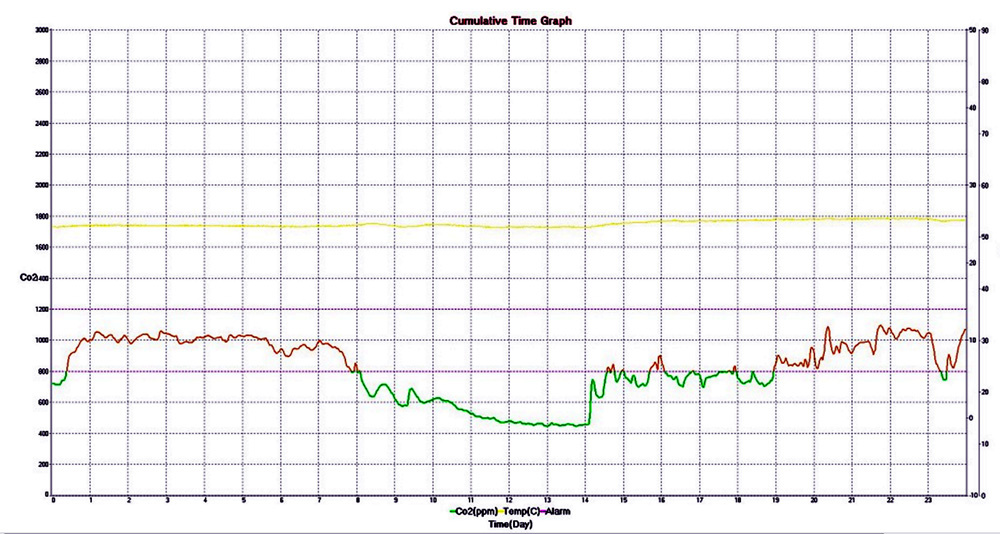
At night, a window is open in the room, the CO2 concentration is slightly exceeded, but still does not grow to completely wild values.
From 8 to 14 o'clock - there is nobody in the apartment, interior doors are open, windows are open in all rooms. The CO2 concentration drops to the level of outside air.
From 14 to 18 o'clock - there are 2 people in the apartment, interior doors are open, in all rooms there are open vents. The concentration of CO2 is no longer on the street, but in the normal range.
From 18 o'clock and until the morning - in the apartment 3 people, interior doors are closed, the vents are open. CO2 concentration is slightly exceeded, but stable.
Conclusion:if you live alone in a two-room apartment, then you can barely worry about the quality of the air. It is enough only occasionally to air the room. But with two or three inhabitants on the same number of square meters to maintain the concentration of carbon dioxide in the normal range will have to carry out ventilation around the clock.
Experience number 4. CO2 and air conditioning
Now let's see what happens in the room when using the air conditioner.
Baseline: ventilated room, but it is hot outside, and accordingly in the room too.
I close the windows so that the air does not go away, turn on the air conditioner.
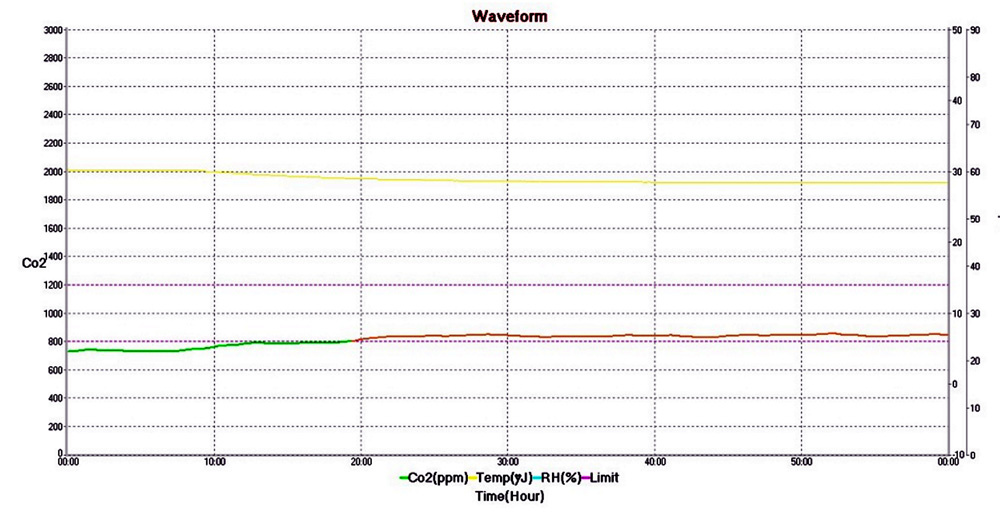
As a result, during the hour of operation of the air conditioner, the temperature in the room dropped by several degrees, and the concentration of CO2 increased.
The trick is that if you do not leave the premises for fresh air, then subjectively, the air in it is perceived as fresh and high-quality simply due to its coolness. And only the numbers on the device show the real picture.
Air conditioning does not replace airing, so sitting in a cozy and cool room all day long can unwittingly “breathe” a CO2 concentration of 2000ppm or even more. This is especially true for offices, where several people are in one small room at once. It is a common misconception that once a separate air duct is mounted for an air conditioner directly on the street, the air conditioner takes the outside air, cools it inside and releases it into the room. In fact, the air duct serves to emit hot air from a room to the street, that is, it works as an exhaust hood. And such air conditioners are far from being everywhere. The usual split system “chases” the indoor air in a circle, and cool refrigerant flows through the tubes.
Using the air conditioner should be aware of the need to saturate the room with fresh air.
5. Home automation
At the end of the review I would like to note that the scope of the CO2 detector is not limited to just measuring and plotting on a computer.
This device can be used in home automation projects, and this can be done in two different ways.

The first method is to connect the power relay to one of the indicator LEDs.
The principle of operation is obvious: when the concentration of CO2 in the air increases, the green indicator changes to yellow, and the electronic key in the relay automatically closes, which in turn turns on the device connected to the relay (for example, a supply fan).

The second method is software.
Since the detector supports data transmission from the sensor to the computer via the USB protocol, it can be embedded into any homemade “smart home” system, reading the readings from the sensor to the head unit. And already from the head unit, on the basis of the received indicators, control another electronics connected to the system.
6. Conclusions
It was interesting to see the real state of the air in my apartment. Using a CO2 detectorit became clear that the available passive ventilation is inefficient, and if in the warm season it is still possible to keep the windows open almost around the clock (although it is not always convenient in summer due to street noise), then in winter it is not feasible due to the rapid cooling of the rooms. There was a reason to think about the modernization of home ventilation, and about maintaining a healthy indoor climate as a whole. In addition, the assortment of the store has an advanced air quality monitor , which has a larger display and makes it possible to measure, in addition to CO2 concentration and temperature, the relative humidity of the air. A 10% discount is available on the GT-CO2 promo code for 14 days.
One of the following articles will describe how to make a CO2 detector friend with a Raspberry Pi microcomputer.
Author: Dmitry Chebanko, Chelyabinsk
Bloggers and authors
The company “Dadzhet” is interested in publishing independent objective reviews of our dadzhetov. We will gladly provide the djadgets to authors who want to test them, write and publish a review on our blog. Dadzhet after writing a review remains with the author. More details .
